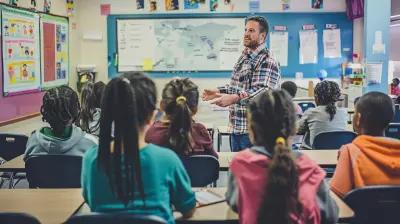Differentiating Instruction for English Language Learners
29 March 2025
As classrooms around the world become more culturally and linguistically diverse, teachers face a unique challenge – how to ensure that every student, regardless of their language background, thrives academically. English Language Learners (ELLs) often require additional support to succeed, especially when they are navigating not just new content, but also the complexities of a new language. This is where differentiated instruction comes into play.
If you’re a teacher or an educator, you've probably heard the term "differentiating instruction" thrown around. But what exactly does it mean, and how can you tailor it to the needs of English Language Learners? Let's get into it.

What is Differentiated Instruction?
In its simplest form, differentiated instruction is all about meeting students where they are. It’s a teaching philosophy that acknowledges that students come into the classroom with different learning styles, abilities, and needs. Instead of adopting a one-size-fits-all approach, teachers who differentiate instruction adjust their teaching methods to help students achieve the same goal, but through paths that are more suited to them.Imagine a classroom where some students excel with written instructions, while others learn better through hands-on activities or group discussions. In that kind of scenario, differentiation allows educators to offer multiple ways to engage with the material, ensuring that every student has a fair shot at understanding and success.
For English Language Learners, differentiation is even more crucial because they’re learning content and language simultaneously.

Why Differentiation Matters for English Language Learners
You might ask, "Why can't I just teach the same way to everyone?" Well, think about it this way: Imagine you're learning how to juggle while also trying to memorize a complex set of rules. Overwhelming, right? That’s what it can feel like for ELLs trying to learn the subject matter in a language they are still processing.Differentiating instruction for English Language Learners isn't just a good idea – it’s essential. ELLs have varying levels of proficiency in English, different cultural backgrounds, and unique learning needs. If instruction isn't tailored to these differences, they may fall behind, become disengaged, or feel frustrated.
But, here's the good news: with the right strategies, teachers can create an inclusive environment where both native and non-native English speakers thrive equally. Let’s explore how.

Key Strategies for Differentiating Instruction for ELLs
1. Know Your Students' English Proficiency Levels
Before diving into content-specific strategies, it’s important to understand each student's English proficiency level. The five levels of English proficiency—beginner, intermediate, advanced, proficient, and native—serve as a guide for tailoring instruction.- Beginners may rely more on visuals, gestures, and basic vocabulary to understand the content.
- Intermediate learners might understand some content but still struggle with complex sentence structures or academic vocabulary.
- Advanced learners can engage with more complex material but may still need support with nuanced language.
Understanding where your students are on this continuum will help you tailor your lessons accordingly.
2. Use Visual Aids and Graphic Organizers
Visuals are worth a thousand words, especially for ELLs. If students are struggling with language, pictures, diagrams, maps, and charts can be incredibly helpful tools for conveying meaning.For example, when teaching about ecosystems, you can use a diagram of a food web or food chain. This visual representation allows ELLs to grasp key concepts without relying solely on their understanding of English.
Graphic organizers like Venn diagrams, flowcharts, and concept maps also help students organize their thoughts and make connections between ideas. These tools create a visual framework for ELLs to process information, making it more digestible.
3. Incorporate Total Physical Response (TPR)
Total Physical Response (TPR) is a fantastic technique for younger learners or beginners. This method involves using physical movement to teach language. For instance, if you’re teaching action verbs like "jump," "run," or "clap," you can have students physically act out the words.Not only does this engage students in a fun and interactive way, but it also reinforces the connection between language and meaning. TPR works wonders because it taps into multiple senses, making it easier for ELLs to retain and recall information.
4. Differentiate by Offering Multiple Reading Levels
In many classrooms, textbooks and reading materials are often above the current linguistic capabilities of ELLs. Instead of expecting all students to read the same text, offer resources at different reading levels.For example, if you're reading a novel or a historical article, provide modified versions with simpler language or summaries for lower-proficiency students. You can also give students access to audiobooks or allow them to read along while listening. This way, ELLs are still engaging with the same content, just in a way that’s accessible to them.
5. Pair Up Students for Peer Learning
Collaborative learning can be a game-changer for ELLs. Pairing them with native English speakers or more proficient students can help scaffold their learning. These “buddies” can clarify instructions, explain difficult concepts, or model fluent speaking.However, be cautious of relying too heavily on peer support. The idea is to create a balanced partnership where both students benefit. While the more proficient student offers linguistic assistance, the ELL may contribute a unique perspective or cultural insight, creating a mutually enriching experience.
6. Offer Choices for Student Output
Not all students need to show what they’ve learned in the same way. While traditional assessments like essays and tests are common, ELLs may struggle with these forms of output due to language barriers.Offer alternative ways for ELLs to demonstrate their understanding, such as:
- Oral presentations
- Graphic presentations (e.g., posters, infographics)
- Dramatizations
- Multimedia projects (e.g., videos or slideshows)
These alternatives allow ELLs to express their grasp of the material without being limited by their current language proficiency.
7. Scaffold Instruction
Scaffolding is a teaching strategy that involves providing students with temporary supports that help them achieve a learning goal. For ELLs, scaffolds can take many forms, such as:- Sentence starters to help students construct written responses.
- Word banks that offer key vocabulary they can use in their writing or speaking.
- Modeling by the teacher, where you demonstrate a task or response before asking students to do it independently.
The key with scaffolding is to gradually remove the supports as students gain confidence and proficiency.
8. Use Technology to Your Advantage
In today’s digital age, technology offers endless possibilities for differentiating instruction – especially for English Language Learners. There are numerous apps, websites, and tools designed to support language learning and content comprehension.For instance:
- Duolingo and Rosetta Stone are great for building vocabulary and grammar skills.
- Quizlet allows students to create digital flashcards, a great way to reinforce key terms.
- Google Translate can help with quick translations, though it shouldn’t be relied on exclusively.
- FluentU offers real-world videos, which can be both engaging and educational for ELLs.
By incorporating these tools into your teaching, you can provide additional practice and support that students can use both inside and outside the classroom.
9. Encourage Cultural Connections
ELLs come from diverse cultural backgrounds, and these cultural experiences are assets in the classroom. Encouraging students to make connections between the content and their own lives can help them feel more engaged and invested in the learning process.For instance, if you’re teaching about holidays, ask students to share traditions and celebrations from their own cultures. Not only does this make the learning experience more meaningful for ELLs, but it also fosters a more inclusive classroom environment where all students’ backgrounds are respected and valued.
10. Be Patient and Provide Clear, Concise Instructions
Last but not least, patience is key. Learning a new language takes time, and ELLs may require additional explanation, repetition, and support. It’s important to provide clear, concise instructions and to check in regularly to ensure students understand what’s expected of them.When giving directions, it’s often helpful to break tasks into smaller, more manageable steps. Additionally, using simple language and avoiding idioms or overly complex vocabulary can help ELLs follow along more easily.

Final Thoughts
Differentiating instruction for English Language Learners may seem like a daunting task, but it’s entirely doable with the right mindset and strategies. By understanding your students’ needs, using a variety of instructional techniques, and fostering an inclusive classroom environment, you can ensure that every learner has the opportunity to succeed—no matter their language background.Remember, the goal isn’t perfection but progress. Every small adjustment you make can have a big impact on an ELL’s learning journey.
all images in this post were generated using AI tools
Category:
Differentiated InstructionAuthor:

Olivia Chapman
Discussion
rate this article
7 comments
Uriah McKee
Like a chameleon in a rainbow, differentiating instruction for English Language Learners adds vibrant hues to the classroom! Let’s turn language puzzles into playful treasure hunts—who’s ready to dive into the quirkiness?
May 1, 2025 at 3:40 AM

Olivia Chapman
Absolutely! Embracing the uniqueness of each learner enriches our classrooms. Let's make learning an adventure!
Norah Porter
Great insights on supporting English Language Learners! Practical strategies like these make a significant impact.
April 6, 2025 at 4:47 AM

Olivia Chapman
Thank you! I'm glad you found the strategies helpful for supporting English Language Learners. Your feedback means a lot!
Renee Morgan
This article effectively highlights the importance of tailoring instructional strategies to meet the diverse linguistic needs of English Language Learners. By emphasizing differentiation, educators can foster an inclusive environment that promotes language acquisition and academic success for all students.
April 4, 2025 at 4:02 AM

Olivia Chapman
Thank you for your thoughtful comment! I'm glad you found the article's emphasis on differentiation for English Language Learners valuable in promoting an inclusive learning environment.
Lira McFee
Great insights! Emphasizing diversity enhances learning for everyone.
April 3, 2025 at 4:24 AM

Olivia Chapman
Thank you! I'm glad you found the insights valuable. Diversity truly enriches the learning experience for all students.
Troy Bellamy
Thank you for this insightful article! The strategies presented for differentiating instruction for English Language Learners are practical and essential for fostering an inclusive classroom environment.
March 31, 2025 at 12:17 PM

Olivia Chapman
Thank you for your kind words! I'm glad you found the strategies useful for creating an inclusive environment.
Everett Taylor
Great insights on differentiating instruction for English Language Learners! Tailoring approaches to individual needs is crucial for their success. Strategies like visual aids and collaborative learning can significantly enhance engagement and comprehension. Thanks for sharing these valuable tips for educators!
March 30, 2025 at 7:32 PM

Olivia Chapman
Thank you for your thoughtful feedback! I'm glad you found the strategies helpful for supporting English Language Learners.
Peregrine McKittrick
This article highlights effective strategies for differentiating instruction, ensuring that English Language Learners receive the tailored support they need to thrive academically. Great insights!
March 29, 2025 at 1:37 PM

Olivia Chapman
Thank you for your positive feedback! I’m glad you found the strategies helpful for supporting English Language Learners.
MORE POSTS

Tips for Differentiating Instruction in Large Classrooms

Redefining Education with Blockchain Technology

How to Use Technology to Enhance Your Study Plan

The History of Human Rights: A Timeline of Progress

Differentiating Instruction in Art and Music Classrooms

Essential Tools for Building Effective Virtual Classrooms